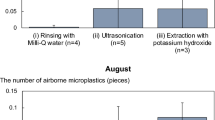Abstract
Algae are used in biomonitoring systems to detect water or soil pollution. So it is conceivable to establish a biomonitoring system for the detection of airborne pollutants (ozone and particulate matter (PM-10)) in urban habitats by algae. Autotrophic biofilms are widely present, cover nearly every exposed surface, especially tree bark and consist of a large variety of species of algae, cyanobacteria and fungi. To explore the diversity of green algae at different air pollution monitoring sites we choose trees with different structures of bark at three locations in and near Leipzig. We compared the measured levels of air pollution with the algal species and communities present. The sites differed in the quality and amount of airborne pollutants, among which we concentrated on ozone and particulate matter (PM-10). The collection sites were Leipzig-Centre, Leipzig-West and a forest area east of Leipzig (Collmberg). Autotrophic biofilms were collected, algae cultures established and taxonomic and morphological studies were carried out with light microscopy. Green algae were present on tree bark at all sites and forty-eight different algal species and cyanobacteria were isolated. Preliminary results suggested a correlation between pollutants and occurrence of some specific algal species and the specific algal assemblages at a given site. It is concluded that this could provide the basis for a biomonitoring system involving aero-terrestrial algae for the detection of airborne pollutants.
Similar content being viewed by others
References
Adamo P., Crisafulli P., Giordano S., Minganti V., Modenesi P., Monaci F., Pittao E., Tretiach M. & Bargagli R. 2007. Lichen and moss bags as monitoring devices in urban areas. Part II: Trace element content in living and dead biomonitors and comparison with synthetic materials. Environm. Pollution 146: 392–399.
Alga growth inhibition test, OECD 201
Altenburger R., Walter H. & Grote M. 2004. What contributes to the combined effect of a complex mixture? Environ. Sci. & Technol. 38(23): 6353–6362.
Andreeva V.M. 1973. Novye vidy Chlorella Beijer. (New species of the Chlorella Beijer.). Bot. Z., Leningrad, 58: 1735–1741.
Andreeva V.M. 1998. Terrestrial and aerophytic green algae (Chlorophyta: Tetrasporales, Chlorococcales, Chlorosarcinales). Nauka, St. Petersburg, 352 pp.
Bischoff H.W. & Bold H.C. 1963. Some soil algae from Enchanted Rock and related algal species. Phycol. Stud. 4, Univ. Texas Pub. 6318: 1–95.
Blett T., Geiser L. & Porter E. 2003. Air pollution-related lichen monitoring in national parks, forests and refuges: guideline for studies intended for regulatory and management purposes, U.S. Department of the Interior & U.S. Department of Agriculture, 26 pp.
Brand F. 1925. Analyse der aerophilen Grünalgenanflüge, insbesondere der proto-pleurococcoiden Formen. Arch. Protistenk. 52: 265–354.
Edlich F. 1936. Einwirkung von Temperatur und Wasser auf aerophile Algen. Arch. Mikrobiol. 7: 62–109.
Ettl H. 1983. Chlorophyta I — Phytomonadina. In: Ettl H., Gerloff J., Heyning H. & Mollenhauer D. (eds), Süßwasserflora von Mitteleuropa 9, G. Fischer Verlag, Jena, 807 pp.
Ettl H. & Gärtner G. 1995. Syllabus der Boden-, Luft-und Flechtenalgen. Gustav Fischer Verlag, Stuttgart — Jena — New York, 721 pp.
Gärtner G. & Ingolić E. 1989. Ein Beitrag zur Kenntnis von Apatococcus lobatus (Chlorophyta, Chaetophorales, Leptosiroideae). Pl. Syst. Evol. 164: 133–143.
Geitler L. 1942. Morphologie, Entwicklungsgeschichte und Systematik neuer bemerkenswerter aerophytischer Algen aus Wien. Flora 136: 1–29.
Görs S., Schumann R., Häubner N. & Karsten U. 2007. Fungal and algal biomass on artificial surfaces quantified by ergosterol and chlorophyll a as biomarkers. Int. Biodeterioration & Biodegradation 60: 50–59
Gorbushina A.A. 2007: Life on the rocks, Environmental Microbiology 9(7): 1613–1631
Grote M., Schüürmann G. & Altenburger R. 2005. Modeling photoinduced algal toxicity of polycyclic aromatic hydrocarbons. Environ. Sci. & Technol. 39(11): 4141–4149.
Handa S., Nakano T. & Takeshita S. 1991. Some corticous algae from Shibetu, Hokkaido, Northern Japan. J. Jap. Bot. 66(4): 211–223.
Heath R. L. 1994. Possible mechanisms for the inhibition of photosynthesis by ozone. Photosynth. Res 39: 439–451.
Hilge C., Petersen K. & Krumbein W.E. 1998. Rolle des bei UV-Strahlung freiwerdenden Ozons bei der Schädigung von Mikroorganismen. Z. Kunsttechnol. & Konservierung, pp. 162–173.
Höhn B. 2002. Bodennahes Ozon — Entstehung — Wirkung — Maßnahmen, Ministerium für Umwelt und Naturschutz, Landwirtschaft und Verbraucherschutz des Landes Nordrhein-Westfalen.
DIN 38412 — Teil 33 1991. Bestimmung der nicht giftigen Wirkung von Abwasser gegenüber Grünalgen (Scenedesmus-Chlorophyll-Fluoreszenz-Test) über Verdünnungsstufen.
Komárek J. & Fott B. 1983. Das Phytoplankton des Süßwassers (7. Teil — 1. Hälfte), In: Huber-Pestalozzi, G. (ed.) Die Binnengewässer Band XVI, Schweizerbart, Stuttgart, 1044 pp.
Lokhorst G.M. & Vroman M. 1974. Taxonomic studies on the genus Ulothrix (Ulotrichaes, Chlorophyceae) II. Acta Bot. Neerl. 23: 369–398.
Loreto F. & Velikova V. 2001. Isoprene produced by leaves protects the photosynthetic apparatus against ozone damage, quenches ozone products, and reduces lipid peroxidation of cellular Membranes. Plant Physiol. 127: 1781–1787.
Pauls K.P. & Thompson J.E. 1980. In vitro simulation of senescence-related membrane damage by ozone-induced lipid peroxidation. Nature 283: 504–506.
Reisser W. & Houben P. 2001. Different strategies of aeroter-restrical algae in reacting to increased levels of UV-B and ozone. Nova Hedwigia, Beih. 123: 291–296.
Rindy F. & Guiry M.D. 2004. Composition and spatial variability of terrestrial algal assemblages occurring at the base of urban walls in Europe. Phycologia 43(3): 225–235.
Schmidt G. 1927. Zur Ökologie der Luftalgen, Ber. dtsch. bot. Ges. 45: 518–533.
Steiner M. & Schulze-Horn D. 1955. Über die Verbreitung und Expositionsabhängigkeit der Rindenepiphyten im Stadtgebiet von Bonn. Decheniana 108/1: 1–16.
Stroh K. 2004. Bodennahes Ozon. Bayrisches Landesamt für Umweltschutz, 7 pp.
Yair A. 2001. Effects of Biological Soil Crusts on Water Redistribution in the Negev Desert, Israel: a Case Study in Longitudinal Dunes. Ecol. Stud. 150: 303–314. In: Belnap, J. & Lange, O. L. (eds), Biological soil crusts: structure, function and management. Springer — Verlag, Berlin-Heidelberg.
Yamamoto Y., Miura Y., Higuchi M., Kinoshita Y. & Yoshimura I. 1993. Using lichen tissue cultures in modern biology. The Bryologist 96/3: 384–393.
Author information
Authors and Affiliations
Corresponding author
Rights and permissions
About this article
Cite this article
Freystein, K., Salisch, M. & Reisser, W. Algal biofilms on tree bark to monitor airborne pollutants. Biologia 63, 866–872 (2008). https://doi.org/10.2478/s11756-008-0114-z
Received:
Accepted:
Published:
Issue Date:
DOI: https://doi.org/10.2478/s11756-008-0114-z




